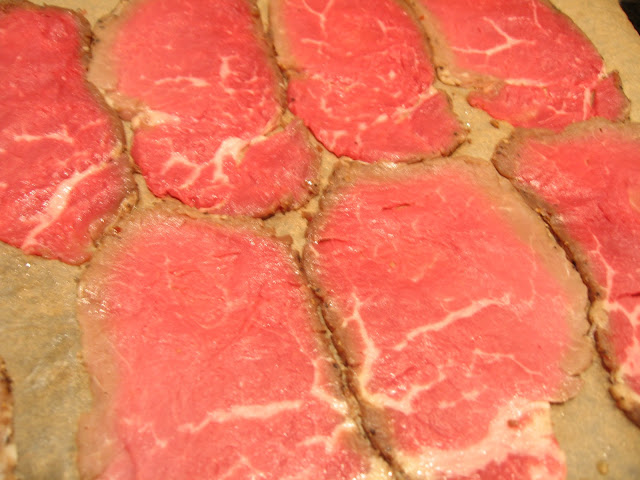I served this wonderful party food on New Year's Eve, for a small gathering of family and some visiting friends from London. The presentation was lovely and interesting, and the dish proved a real crowd-pleaser. If you've ever had one of those fouffy faux rolls of beef tenderloin at a sushi restaurant, it was likely a version of negi maki.
As finger foods go, this is straightforward and healthy, with a deep flavor. Too often hors d'oeuvres depend on puff pastry, butter, or loads of cheese. The greasy bits are bad for fancy clothes, and the goo just weighs you down too much prior to the meal. Leave it to the Japanese to simplify and beautify the humble hors d'oeuvres.
This recipe is easy, but specific. Assemble ahead, marinate, and throw on the grill just before you'd like to serve.
This is adapted from Gourmet, March 2004.
- 12 small scallions, trimmed to 6-inch lengths
- 6 asparagus stalks, trimmed to 6-inch lengths (from tip)
- 1 (1-lb) piece flank steak (roughly 6 to 7 inches square)**Snob alert, I used a tenderloin of filet mignon. In full disclosure, though, Trader Joes sells this superb cut at a reasonable price. The flavor and tenderness is AMAZING.
- 1/4 cup sake (Japanese rice wine)
- 1/4 cup mirin* (Japanese sweet rice wine)
- 3 tablespoons soy sauce
- 1 tablespoon sugar
- 1 tablespoon vegetable oil
Prepare scallions and asparagus:
Slice asparagus lengthwise, in half if small, or quartered if large. Blanch asparagus and scallions in a large pot of boiling salted water 45 seconds, then transfer with a slotted spoon to a bowl of ice and cold water to stop cooking. Transfer to paper towels to drain and pat dry.
Slice asparagus lengthwise, in half if small, or quartered if large. Blanch asparagus and scallions in a large pot of boiling salted water 45 seconds, then transfer with a slotted spoon to a bowl of ice and cold water to stop cooking. Transfer to paper towels to drain and pat dry.
Prepare beef:
Cut flank steak with the grain holding a large knife at a 30-degree angle to cutting board into 12 (1/8-inch-thick) slices (1 1/2 to 2 inches wide). This is hard, but be patient.
Cut flank steak with the grain holding a large knife at a 30-degree angle to cutting board into 12 (1/8-inch-thick) slices (1 1/2 to 2 inches wide). This is hard, but be patient.
Arrange slices 1 inch apart on a very lightly oiled sheet of parchment paper or plastic wrap, then cover with another very lightly oiled sheet of parchment or plastic wrap (oiled side down) and pound slices with flat side of meat pounder or roll out with a rolling pin until about 1/16 inch thick. You should almost be able to see through it at this thickness.
 |
| Experiment with thickness, depending on the cut of beef you have. |
Assemble rolls:
Arrange 3 beef slices side by side on a fresh sheet of plastic wrap, overlapping slices slightly to form a 6-inch square with short ends of slices nearest you.
Arrange 3 beef slices side by side on a fresh sheet of plastic wrap, overlapping slices slightly to form a 6-inch square with short ends of slices nearest you.
Sprinkle square lightly with a pinch of salt, then lay 3 scallions (with some white parts at both ends) across slices at end closest to you and tightly roll up meat around scallions to form a log, using plastic wrap as an aid if you like. It's how the Japanese do it, but it just trips me up.
Tie log with kitchen string at ends and where meat slices overlap--or use toothpicks to secure. Make 3 more rolls in same manner.
Marinate rolls:
Stir together sake, mirin, soy sauce, and sugar in a small bowl until sugar is dissolved.
Stir together sake, mirin, soy sauce, and sugar in a small bowl until sugar is dissolved.
Put rolls in a small baking dish and pour marinade over them, turning to coat. Marinate, loosely covered with plastic wrap, turning occasionally, 15 minutes to 2 hours.
Cook rolls:
Remove rolls from marinade, reserving marinade. Cook as desired:
Remove rolls from marinade, reserving marinade. Cook as desired:
1. I prefer to fire up the grill, as is the traditional Japanese method. These cook pretty fast, no more than 4 minutes total.
OR
2. Brown them in a 10-inch pre-heated heavy skillet over moderately high heat with a bit of vegetable oil. Again, 4 to 5 minutes total for medium-rare.
Transfer rolls to cutting board. Add marinade to skillet and boil until slightly syrupy, 1 to 2 minutes, then remove from heat. Be careful not to scorch it--the high sugar content will burn fast. If you DO botch the sauce, just whip together your favorite combo of Asian condiments--whatever you have on hand. Siracha, soy sauce, wasabi powder, chili oil, etc.
After rolls have rested a few minutes, discard strings or toothpicks, then cut each roll crosswise into 6 slices. Drizzle sauce over top or place on the side in a dipping boil.




1 comment:
Mmm. The only kind of beef I eat is raw - pretty. Also, I think this could be awesome Valentines' Day food!
Post a Comment